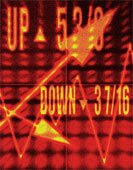MarketWatch had an interesting write-up in “Stupid investment of the week,” which featured the latest and greatest new thing called 130/30 funds. Sure, with ETFs steeling a lot of the mutual fund business, it was time for a new invention no matter whether it made sense or not.
In case you never heard of 130/30 funds, here’s the definition:
The 130/30 moniker reflects what these funds do. Typically, a 130/30 fund invests 130% of its assets in “long positions” — stocks on which the manager is betting that the price is going up — and 30% in short positions, where the expectation is that the price will go down.
In a short sale, the seller borrows stock and sells it on the open market, getting the cash from the sale. If the stock’s share price falls, the investor buys back the shares at a lower price, returns them and pockets the difference.
The proceeds from those short sales create the extra 30% of long exposure. On a net basis, the extra long and the short position cancel out and the fund can claim to be “fully invested.” For the average investor, however, the idea is that the extra investment, theoretically, turbocharges returns.
In a traditional fund, the manager can put money only into stocks that appear headed for takeoff. In a 130/30 fund, the manager gets to put all of his information to work, betting on crash landings, too, a hedge that is particularly attractive in times like these, when the market is struggling the way it is right now.
It’s a different twist on long-short funds and market-neutral funds, both of which brought certain qualities of hedge funds — notably a purported ability to make money in all market conditions — to ordinary mutual funds. Alas, the vast majority of those fund types have failed to deliver on their potential; most market-neutral funds have been unable to make decent money in all market conditions.
The article goes on to refer to two funds namely MAMSX and RUSAX, which have been on the market for less than a year. A picture is worth a thousand words, so let’s take a look at the chart:

The obvious goal of 130/30 funds, or long/short funds for that matter, is to make money no matter which way the markets trend. Both funds have failed miserably so far and pretty much followed the S&P; 500 into bear market territory.
While the intent of designing a strategy that works in bull and bear environments is a noble one, 130/30 funds seemed to have missed that mark by a mile.







